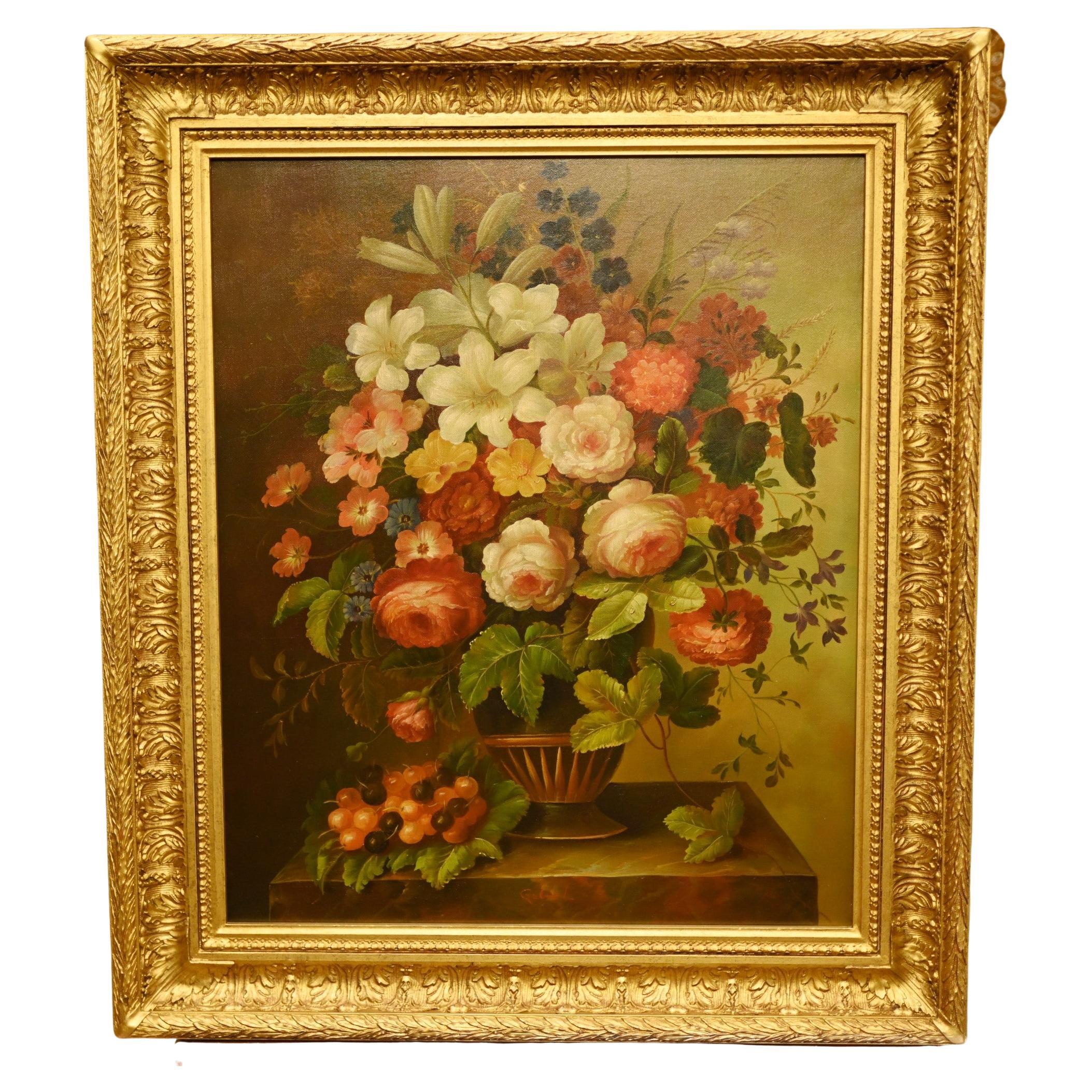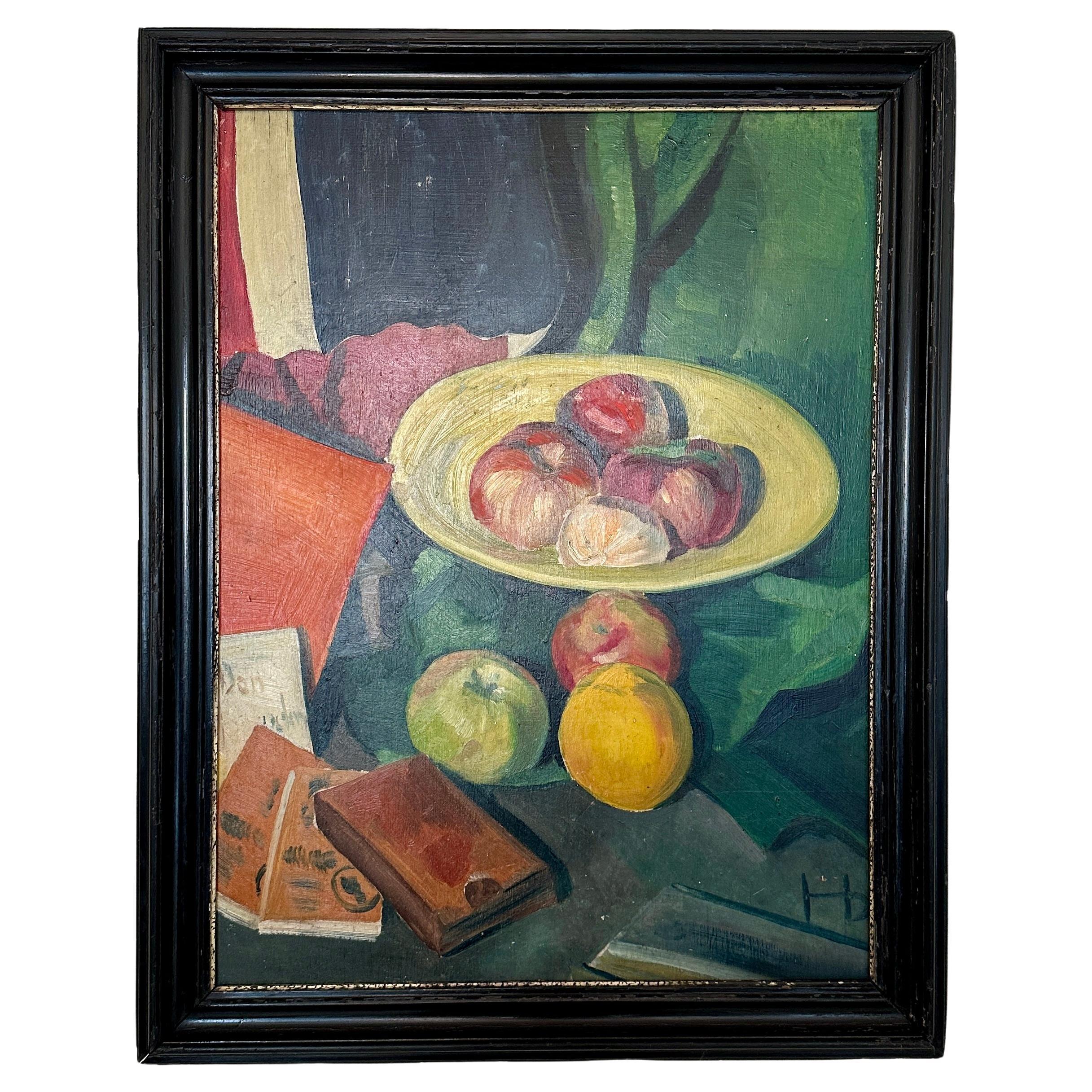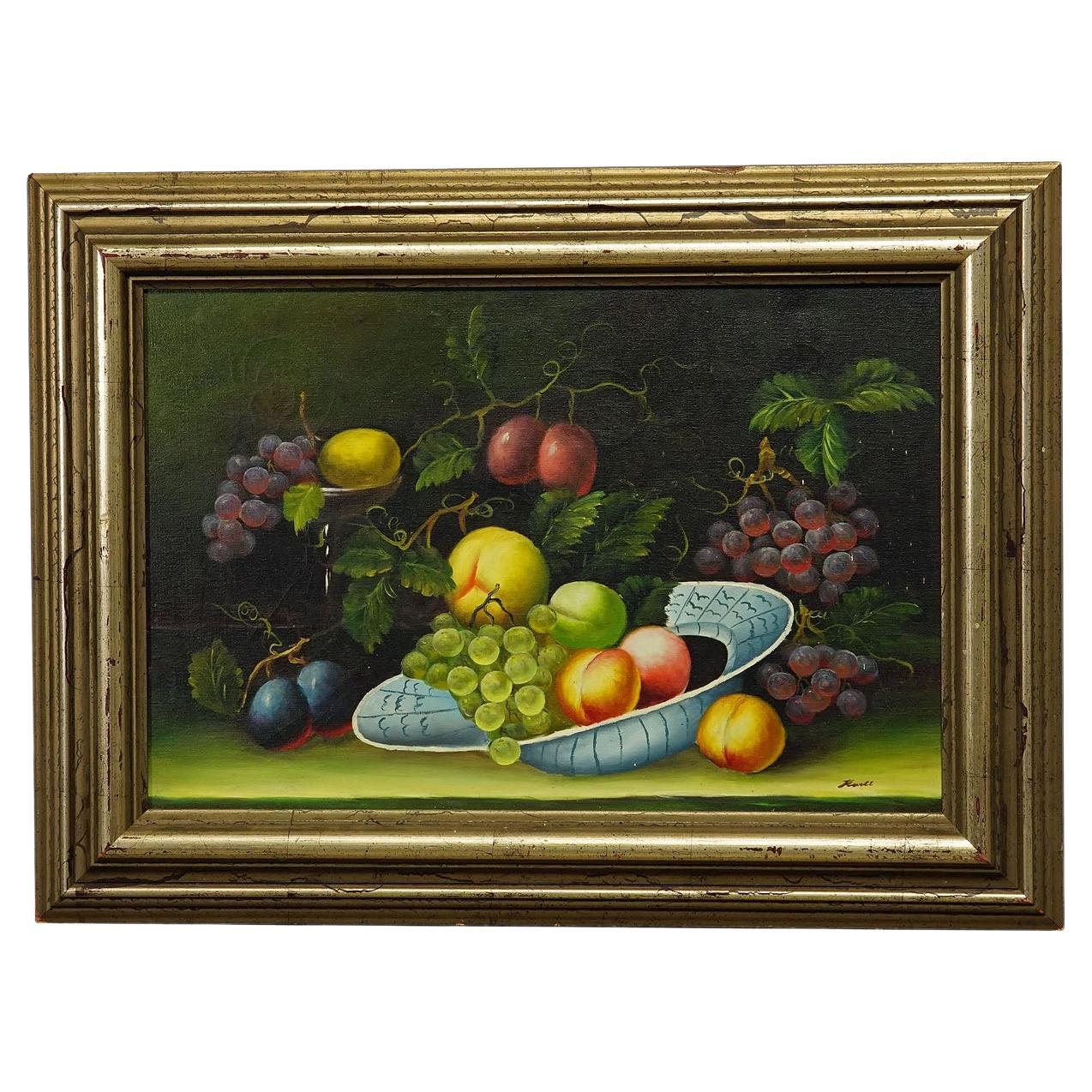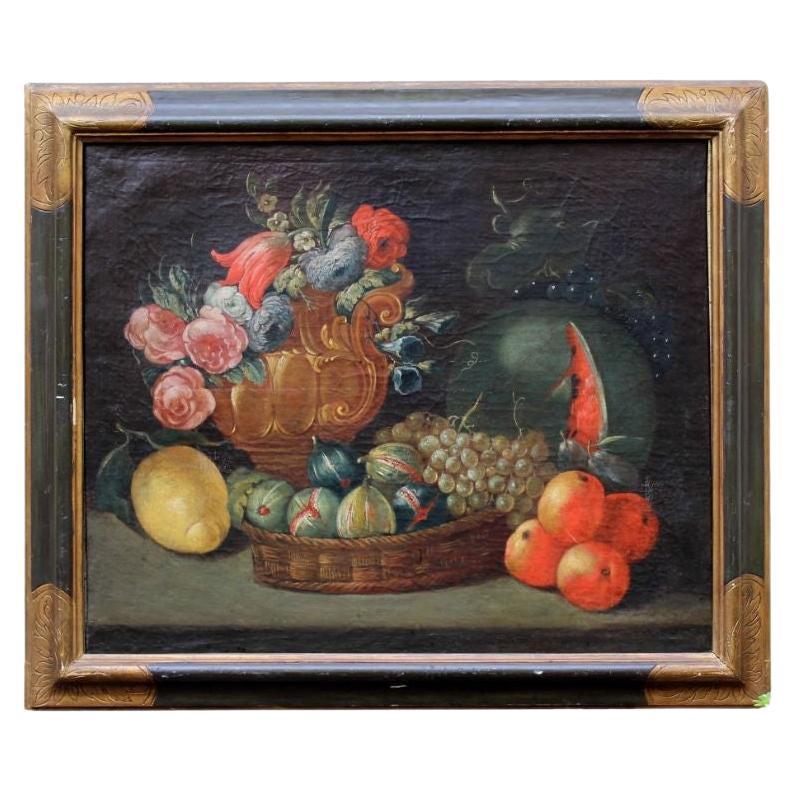Items Similar to Nicolas Issaiev, Still Life with Fruits, Original Oil Painting, Ca. 1920’s
Want more images or videos?
Request additional images or videos from the seller
1 of 6
Nicolas Issaiev, Still Life with Fruits, Original Oil Painting, Ca. 1920’s
About the Item
Nicolas Issaiev (a/k/a Nikolai Alexandrovich Isaev, Russian-French, 1891-1977) was a painter, graphic artist, set designer, illustrator.
In the early 1900s he studied in art schools in Odessa and Kharkiv, Ukraine; and in 1912, he moved to Saint Petersburg. During World War I, Isaev entered the military academy. In 1916, he participated in combat action at the Galician Front and was wounded. In 1919, Isaev emigrated to the Kingdom of Serbs, Croats and Slovenes. In 1920, he worked as set designer at the National Theatre in Belgrad, where he also created costume sketches, theatricals; and copied Byzantine frescoes. During that time, the artist held his first personal exhibition.
In 1925, Isaev moved to Paris. In 1925-1926, he attended classes at V.I.,Shukhaev and A.E.,Yakovlev workshop. In 1926, he held a day-long personal exhibition. Later he attended the Ranson Academy and was under strong influence of the cubist painter, Roger Bissière. In 1938, he spent some time working in Bissière’s studio. Just like many other Russian emigrant artists he created theatricals, worked as set designer (G. Pitoev theatre).
He decorated the pavilion of the Baltic countries at the 1937 Paris International Exposition. Some of his Russian artist friends included D.V. Merinov and G. Lebedev.
Isaev took active part in the Paris salons - the Autumn Salon, the Salon des Indépendants, the Salon des Surindépendants, the Salon Comparaisons and the Salon des Tuileries.
He also participated in exhibitions of Russian art in Brussels (1928), Paris (Alice Manteau, 1931; d’Alignan, 1931; La Renaissance, 1932) and Prague (1935) and in the exhibitions of the Circle group in Belgrade (1931). Isaev held personal exhibitions at the Paris Lesnik (1928), AtelierMme Margaret Train Embre (1930), La Bo?tie (1930) galleries.
He donated artworks for charity in a benefit for the Russian youth (1928), the members of the Union of former figures of the Russian judicial institution (1935).
In 1940-1945, Isaev lived in the south of France, in Agen. He and his wife hid partisans and French officers in their house. In 1971, Issaev was awarded with the Cross of the resistance volunteer combatant.
After the war Isaev travelled in Europe a lot, visiting Switzerland, Italy and Spain. On his journeys the artist created numerous landscapes, frescoes and icons for the Uniat churches in Marseille and Strasbourg. His manner at that time changed prominently: the colors became brighter and the art was more figurative. Isaev took part in the exhibitions of Russian art organized by the France - USSR committee and the Union of the Russian Patriots.
He illustrated several books, including The Flowers of Evil by Charles Baudelaire, Love Sonnets by Pierre De Ronsard, The New Extraordinary Stories by Edgar Allen Poe, The Nose by Nikolay Gogol (exhibited at the Paul Valéry club, 1954). Isaev collaborated with C’est Paris magazine.
Isaev’s later artworks (mainly landscapes) show his returned interest to cubism.
In 1965, the artist presented his works at a group exhibition of European art in New-York. He participated in the Russian Artists of the Paris School(1961) and The Russian Glance (1974) exhibitions.
In 1976, a posthumous exhibition of the artist took place in Paris. In 1991, after 15 years of storage, his artistic heritage (more than 200 canvases, several hundred of drawings, watercolors, gouache and pastel paintings, and illustrations) was sold at the Drouot auction.
- Creator:Nikolai Alexandrovich Isaev (Painter)
- Dimensions:Height: 11.75 in (29.85 cm)Width: 13.75 in (34.93 cm)Depth: 2 in (5.08 cm)
- Style:Expressionist (Of the Period)
- Materials and Techniques:
- Place of Origin:
- Period:
- Date of Manufacture:circa 1920s
- Condition:Wear consistent with age and use. We make our best effort to provide a fair and descriptive condition report. Please examine photos attentively, as they are part of the description. Send us a message to request more details or discuss price.
- Seller Location:New York, NY
- Reference Number:1stDibs: LU2819323249232
About the Seller
5.0
Vetted Seller
These experienced sellers undergo a comprehensive evaluation by our team of in-house experts.
Established in 1993
1stDibs seller since 2017
68 sales on 1stDibs
Typical response time: 2 hours
- ShippingRetrieving quote...Ships From: New York, NY
- Return PolicyA return for this item may be initiated within 10 days of delivery.
More From This SellerView All
- Ivan Olinsky, Still Life w/ Chinese Porcelain Figurine & Fruits, O/C Painting, CBy Ivan Grigorievich OlinskyLocated in New York, NYArtist: Ivan Grigorewitch Olinsky (Russian-American, 1878 1962) Subject: Still life w/ Chinese porcelain figurine & fruits Period: 1920’s...Category
Vintage 1920s American Expressionist Paintings
MaterialsCanvas
- Henry Carnier, Oriental Medina Street Scene, Original O/C Painting, Ca. 1880sLocated in New York, NYABOUT This eye-pleasing painting was created by the famous French painter, Henry Carnier (French, 1843-1902) around 1880s; that is, at the height of the Belle Époque artistic movem...Category
Antique 1880s French Belle Époque Paintings
MaterialsCanvas
- Emmanuel Fougerat, O/C Portrait of La Argentinita, ca. 1920By Emmanuel FougeratLocated in New York, NYDIMENSIONS: Height: 16.25 inches Width: 13.5 inches Depth: 2.25 inches Frame width: 2.5 inches ABOUT MODEL Encarnación López Júlvez, known as La Argentinita (Buenos Aires, March 3, 1898 – New York, September 24, 1945) was a Spanish-Argentine flamenco dancer (bailaora), choreographer and singer. La Argentinita was considered the highest expression of this art form during that time. López Júlvez was the daughter of Spanish immigrants in Argentina, where her father had a fabric business. While living there, two of her siblings died in a scarlet fever epidemic. Consequently, she was brought to the north coast of Spain in 1901, where she began to learn Spanish regional dances. When she was only four years old, she started learning flamenco from Julia Castelao. Her first public performance was at the age of eight at the Teatro-Circo de San Sebastián, in the Basque Country. She chose the name "La Argentinita" in deference to the famous flamenco dancer Antonia Mercé (La Argentina). After travelling throughout Spain as a child prodigy, she settled in Madrid to perform at Teatro La Latina, Teatro de la Comedia, Teatro de La Princesa, Teatro Apolo and Teatro Príncipe Alfonso. Her success led her to tour in Barcelona, Portugal and Paris, and then Latin America. In the early 1920s, she returned to Spain, where she worked in Madrid. Among her early performances was the 1920 premiere of Federico García Lorca's musical play El maleficio de la mariposa as "the Butterfly". She announced her retirement in 1926, but would quickly return to the show business as part of the artistic renewal that led her to the Generation of ‘27, in which she combined flamenco, tango, bulerías and boleros. She danced to the compositions of Manuel de Falla, Joaquín Turina, Isaac Albéniz, Enrique Granados and Maurice Ravel. She helped in the development of Ballet Español. Adapting pieces to popular tradition, she toured Europe, triumphing in Paris and Berlin and participating in the artistic movements of that time along with Spanish poets such as Rafael Alberti, Federico García Lorca, Edgar Neville and Ignacio Sanchez Mejias. Sánchez Mejías, an intellectual and bullfighter, was a married man and her lover. La Argentinita retired a second time to maintain her clandestine relationship with him. However, she would return to the stage with the aid of Sánchez Mejías, who participated in the search and employment of interpreters for her subsequent performances. In 1931, López Júlvez and García Lorca recorded five gramophone slate records, which were accompanied by García Lorca's piano. The selection of songs was prepared, adapted and titled Colección de Canciones Populares Españolas by García Lorca. Among the ten songs were "Los cuatro muleros", "Zorongo gitano", "Anda Jaleo" and "En el Café de Chinitas". With the beginning of the Second Spanish Republic, López Júlvez formed her own ballet company called Bailes Españoles de la Argentinita together with her sister, Pilar López Júlvez, and García Lorca. López Júlvez staged several flamenco theatrical shows, including an adaption of Falla's El amor brujo (Love, the Magician) in 1933, and Las Calles de Cádiz (The Streets of Cadiz) in 1933 and 1940.[7] She travelled through Spain and Paris, where she was recognized as one of the most important flamenco artists of her time. Her company included the flamenco figures Juana la Macarrona, La Malena, Fernanda Antúnez, Rafael Ortega and Antonio de Triana, who was her first dancing partner until the 1940s. At the end of her tour around Spain, her lover Sánchez Mejías was gored to death in 1934 in the Manzanares bullring. She sought refuge in her work and moved to Buenos Aires to dance at the Teatro Colón; from there she embarked on a long American tour. In 1936 she achieved success in New York. Afterwards, she returned to Spain but was forced to flee the country shortly before the outbreak of the Spanish Civil War. She travelled through Morocco, France, the UK, the Netherlands, Belgium and the USA, where she remained in exile in New York. From then until her death in 1945, she developed her career and became one of the biggest stars of international dance, and even participated in movies. In 1943, she presented the flamenco troupe El Café de Chinitas at the Metropolitan Opera House in New York, with her own choreography, texts by García Lorca, scenery by Salvador Dalí and the orchestra directed by José Iturbi. In addition, she performed at the Washington DC Watergate complex with her sister. On May 28, 1945, she gave her last performance at the Metropolitan of the orchestral work El Capricho Español, composed in 1887 by Nikolai Rimsky-Korsakov and based on Spanish melodies. At the end of the event, she had to be admitted to a hospital, where she died on September 24 from a tumor in her abdomen. She did not want to have it operated on because she did not wish to abandon dancing. Her body was repatriated to Spain in December and buried in the Spanish capital. That same year, the company of Bailes Españoles de la Argentinita was dissolved. Among the honors she received after her death was a plaque consecrated at the Metropolitan Opera House, positioned among the medals of Alfonso X El Sabio and La Orden de Isabel la Católica to honor her merits in the field of culture. ABOUT ARTIST Emmanuel Fougerat (French, 1869 – 1958) was a renowned French painter, museum curator and art historian. A former student of the Regional School of Fine Arts in Rennes, Fougerat studied in the studio of Albert Maignan and that of Jean-Paul Laurens in Paris. He was appointed director of the Nantes School of Fine Arts and was also the founder and curator of the Museum of Fine Arts in the same city. Emmanuel Fougerat was named Chevalier of the Legion of Honor in 1912. In 1923, he was placed on temporary leave from the French State in order to carry out a mandate as director of fine arts education in the Province of Quebec, Canada; where he served as an art teacher and director of the École des beaux-arts de Montréal from 1923 to 1925. Emmanuel Fougerat’s paintings are in the following public collections: • Nantes Museum of Fine Arts, France. • Museum of Modern Art in Paris, France. • Rennes Town Hall: permanent decorations. • Museum of Fine Arts of Saint-Nazaire (destroyed in 1944), France • National Museum of Fine Arts of Quebec, Canada. Emmanuel Fougerat is also the author of works on several French painters, including Albert Besnard, Paul Baudry...Category
Vintage 1920s French Art Deco Paintings
MaterialsCanvas
- Boris Solotareff, Portrait of Mr. Lautenberg, Oil on Canvas Painting, 1920sBy Boris SolotareffLocated in New York, NYSigned en verso B. Solotareff, Lautenberg. Original period frame, made personally by the artist. Dimensions (without frame): Height 16” Width 12 ½”. Dimensions (with frame...Category
Vintage 1920s French Art Deco Paintings
MaterialsCanvas
- Spanish Colonial, Madonna and Child, Original Oil on Wood Painting, XVIII CLocated in New York, NYSpanish Colonial Madonna and Child Original oil on wood painting XVIII century DETAILS Original period frame. PAINTING DIMENSIONS Height: 6-3/8 inches Width: 7.5 inches Depth:...Category
Antique 18th Century Mexican Spanish Colonial Paintings
MaterialsWood
- Alexander Cañedo, Dancing Man, Surrealistic O/C Painting, ca. 1950’sLocated in New York, NYMid-Century Surrealism Alexander Cañedo Dancing Man Oil on Canvas ca. 1950’s PAINTING DIMENSIONS: Canvas: 44 x 44 cm (17-3/8 x 17-3/8 in.) Framed: 68 x 68 cm (26-3/4 x 26-3/4 in.) Alexander Cañedo (Mexican-American, 1902 – 1978) was born in Mexico City as Alejandro de Cañedo; his father was a Mexican government official and his mother was from the United States. In 1918, when Cañedo was 15, his parents sent him to École nationale supérieure des Beaux-Arts in Paris where he studied under the sculptor Jean Magrou. In 1923, Cañedo traveled to Rome where he continued his art studies. In 1927, Cañedo briefly returned to Mexico. During that trip, the Mexican Government appointed him attaché to the Mexican Embassy in Rome. In 1928, Cañedo held his first art exhibition with the Circolo Artistico in Rome, a collection of pencil drawings. More exhibitions followed in other cities in Europe. That same year, he traveled to the New York City where he exhibited widely. At this point, he began signing his work with just his last name; eventually, he also Anglicized his first name as "Alexander" and dropped the "de". Cañedo was commissioned in 1929 to illustrate the amatory novel Orientale: The Adventure of Therese Beauchamps by the French author Francis de Miomandre. The highly stylized Art Deco results were so successful that he retained Cañedo the following year to illustrate his next novel, The Love Life of Venus. In 1932, Cañedo was invited to have a solo show of his pencil drawings at Walter P. Chrysler, Junior's newly opened Cheshire Gallery, located in the Chrysler Building. He also had a solo exhibition at the Argent Galleries, and participated in shows of the Art Students League of New York, of which he was an active member. By the mid-1930s, Cañedo began exhibiting watercolors. These were shown at solo exhibitions at the Arthur U...Category
Vintage 1950s American Mid-Century Modern Paintings
MaterialsPaint
You May Also Like
- Georgian Still Life Oil Painting Floral FruitsLocated in Potters Bar, GBYou are viewing a gorgeous floral still life oil painting in the Georgian manner Such a vivid spray of bright flowers this will brighten up any room Brush work so detailed and the ch...Category
Vintage 1980s Georgian Paintings
MaterialsCanvas
- 1920s Naive Still Life Oil Painting with Fruits and Books in a Black FrameLocated in Berlin, DETransport yourself to the whimsical world of the 1920s with this charming naive still life oil painting, encased in a sleek black frame. Delightfully rendered, the fruits burst with ...Category
Vintage 1920s German Art Deco Paintings
MaterialsPine
- Still Life with Fruits, Oil Painting on Canvas, Germany, 1950sLocated in Berghuelen, DEStill Life with Fruits, oil painting on canvas, Germany 1950s An impressive Biedermeier style still life painting depicting diverse fruits like plums, grapes or peaches. Painted in ...Category
Mid-20th Century German Biedermeier Paintings
MaterialsCanvas, Wood
- Oliver Clare Still Life Fruits Oil on Board English Painting 1920 Gilt FrameLocated in Dublin, IrelandAn exceptionally fine quality example of a framed still life of fruits oil painting on Artists board by well documented English Artist Oliver Clare, first quarter of the 20th century...Category
Early 20th Century English Edwardian Paintings
MaterialsCanvas, Giltwood
- 19th Century Still Life with Fruits Painting Oil on CanvasLocated in Milan, ITNineteenth century. Still life with fruits. Oil on canvas, 64 x 52 cm. The still life analyzed presents a mixture of floral and fruit elements arranged in a circular order o...Category
Antique 19th Century Italian Paintings
MaterialsCanvas
- Still Life Painting, Flower Pot with Roses and Fruits, Oil Painting on CanvasLocated in Breganze, VIStill life artwork, oil painting on canvas, Flower Pot With Roses And Fruits. Still life painting rich and colorful. Art Déco. The painting expresses the fashion of the late nineteenth and early twentieth centuries. Probably inspired by Russian painting. More precisely in the thirties of the twentieth century and a signature not easily translatable, in fact, on the back of the work on the frame there is a name that probably refers to the author, Vladimir Alexandrovich Kutum. The painting bears a handmade frame in shaped, pinstriped and gilded wood from the contemporary era. This still life, oil painting on canvas dates back to the first half of the twentieth century, Art Deco...Category
Early 20th Century French Art Deco Paintings
MaterialsCanvas





